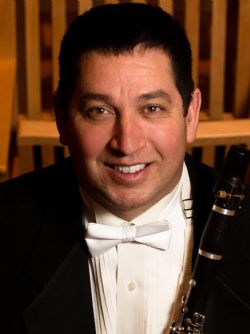|
Symphony
FROM THE NEW WORLD TO THE OLD WORLD
by Peter Lert
Saturday, June 14, 2025
Chamber
MC2 DUO RECITAL CLOSES 222'S SEASON
by Terry McNeill
Saturday, June 14, 2025
Choral and Vocal
CANTIAMO SONOMA'S LUSCIOUS A CAPELLA SINGING IN SEASON ENDING CONCERT
by Pamela Hicks Gailey
Sunday, June 8, 2025
Symphony
SRS SEASON ENDS WITH RESOUNDING TA-TA-TA-BANG
by Terry McNeill
Sunday, June 1, 2025
Symphony
YOUTHFUL VIRTUOSITY ON DISPLAY AT USO'S MAY CONCERTS
by Peter Lert
Saturday, May 17, 2025
Symphony
MYSTICAL PLANETS AND LIVELY GERSHWIN ORTIZ AT FINAL SRS CONCERT
by Peter Lert
Sunday, May 4, 2025
Symphony
VSO'S CONCERT MUSIC OF TIME, MUSIC OF PLACE
by Peter Lert
Sunday, April 27, 2025
VOCAL ELEGANCE AND FIRE AT THE 222'S RECITAL APRIL 26
by Pamela Hicks Gailey
Saturday, April 26, 2025
CANTIAMO SONOMA SINGS AN INSPIRED GOOD FRIDAY MOZART REQUIEM CONCERT
by Pamela Hicks Gailey
Friday, April 18, 2025
DRAMATIC SHOSTAKOVICH SYMPHONY CLOSES PHILHARMONIC'S 25TH SEASON
by Terry McNeill
Sunday, April 13, 2025
|
 |
 Clarinetist Roy Zajac |
PLAYING HEARTS: IT'S ZAJAC IN SPADES
by Steve Osborn
Saturday, February 9, 2013
At symphony concerts, soloists need to be both sonically and visually distinctive. For the latter requirement, what better way to sail above a sea of black-jacketed players than to don a jaunty white blazer with black lapels and a black bowtie? That was the approach soloist Roy Zajac took in a memorable Feb. 9 performance of the Mozart Clarinet Concerto with the Santa Rosa Symphony.
By wearing his trademark "Za-jacket,"� Zajac established his distinction before even playing a note. When the notes did arrive, however, the jacket was as nothing compared to the sonic beauty emerging from the bell of his clarinet. His tone was both liquid and luxurious, each note a perfectly rounded sphere on a string of pearls. His low register was particularly mellow, with occasional deep runs bathing the audience in waves of sound.
Zajac, who normally serves as the Symphony's principal clarinetist, combined the sonic and visual realms by swaying demurely as he played, each motion reflecting a musical phrase. With his feet planted shoulder width apart, he bent at the knees for low notes, swayed right for Mozart's inimitable phrases, and then left for the phrase's echo. You could reconstruct the entirety of the solo line just by watching his ever-changing posture.
And what a solo line it is! The Clarinet Concerto is one of Mozart's greatest compositions, each movement a masterpiece, and the whole even greater than the sum of its parts. In this performance, the opening Allegro was lilting and buoyant, and the closing Rondo up-tempo and joyous. But the most breathtaking movement was the middle Adagio, blessed as it is with some of Mozart's most beautiful melodies. Zajac played these to perfection, coaxing the softest of pianissimos from his instrument and lingering on each passing note. Not even a brief memory lapse could interrupt the flow of this exquisite performance.
Afterward the shy Zajac seemed almost embarrassed by the audience's rousing ovation, and he appeared truly startled when a Symphony staff member presented him with a giant bouquet of yellow roses. With Valentine's Day rapidly approaching, the gesture seemed particularly appropriate. Who couldn't avoid falling in love with a performance such as that?
The rest of the concert, resplendent though it was, stood in Zajac's shadow. The festivities began with the full orchestra, including harp and all manner of imposing percussion and brass, playing Anton Webern's "Passacaglia for Orchestra," Opus 1. As one might expect from an Opus 1, it contained everything but the kitchen sink. Unlike his later austere works, Webern in his youth seemed intent on emulating Mahler and other late Romantics by employing the full forces of the orchestra to create a dense, almost overwhelming, tapestry of sound.
The Passacaglia begins pizzicato and pianissimo, with various sections of the orchestra stating their lines and then fading away. This call-and-response builds up rapidly, however, and soon the entire ensemble is blazing away, only to fade once again and repeat the pattern. The result is a piece that lunges from climax to climax, with little room to breathe.
Despite Webern's youthful excess, Ferrandis and company played the Passacaglia with insight and respect. The various lines were well articulated, and the orchestra combined to make occasional gorgeous sounds. But the Passacaglia can't be more than what it is. No matter what, it's still Opus 1.
In contrast to Webern's Opus 1, Brahms' Third Symphony, Opus 90, is a work of confident maturity and assured artistry, a staple of the symphonic repertoire. It begins majestically and ends with surprising quiescence. In between is some of Brahms' greatest music, most notably the Poco Allegretto third movement, with its distinctive cello line.
The Symphony cellists, urged on by Ferrandis, opened that movement with just the right combination of rhythmic fluidity and silken texture. Their line, eventually picked up by the rest of the orchestra, is really just three notes rising and then three notes falling--simplicity itself. But in the hands of Brahms (and his performers), that six-note motif flowers into a movement of transcendent beauty.
Ferrandis conducted that movement and its predecessors with sweeping gestures that befit his tall frame. His approach changed dramatically in the spirited last movement, where he seemed to get more energy and precision from the players by standing almost still. The more compressed his gestures became, the more results he got. The playing throughout was exemplary, especially from the cellos, who rose as a section at the end of the performance to acknowledge the sustained applause.
[Reprinted by permission of San Francisco Classical Voice.]
|
